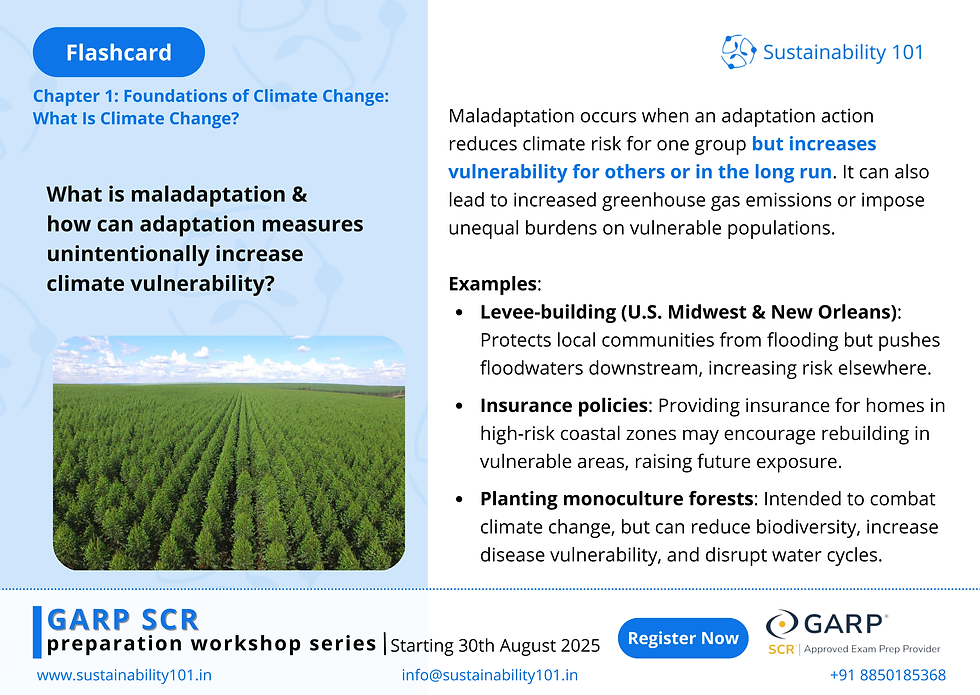GARP SCR- Chapter 1: Foundations of Climate Change: What is Climate Change?
- Sustainability101 Team - Pratiksha More
- Aug 29
- 2 min read
Why is large-scale climate adaptation often difficult to implement at the individual level, and where collective action is required?
Climate Adaptation:
the process of adjusting to the current and future effects of climate change to minimize harm and exploit opportunities
It involves a wide range of actions, from large-scale infrastructure changes like building flood defenses and early warning systems, to behavioral shifts like planting drought-resistant crops and improving water management.
Adaptation is crucial because climate change is already happening, and some impacts are unavoidable, making it necessary to prepare communities and protect ecosystems and livelihoods.

What is maladaptation & how can adaptation measures unintentionally increase climate vulnerability?
Maladaptation in the Context of Climate Change
It refers to actions taken to reduce climate change vulnerability that instead increase it, harm other systems, or create new problems.
Types of Maladaptation:
Rebounding Vulnerability: The initial vulnerability returns or is worsened.
Shifting Vulnerability: Vulnerability is transferred to another group or system that was not the focus of the adaptation strategy.
Creating Negative Externalities: New problems, unrelated to climate change, arise from the adaptation measure.

Compare Solar Radiation Management (SRM) and Carbon Dioxide Removal (CDR). Why might reliance on geoengineering create a moral hazard in climate policy?
Solar Radiation Management (SRM)
How it works:
Aerosol Creation:
Sulfur dioxide or other sulfur compounds are injected into the stratosphere, where they react to form tiny reflective particles known as sulfate aerosols.
Sunlight Reflection:
These aerosols increase the Earth's albedo, or reflectivity, causing a portion of incoming sunlight to be scattered back into space before it can be absorbed by the Earth's surface and oceans.
Planetary Cooling:
By reducing the amount of sunlight that reaches and warms the planet, this effect helps to cool the Earth's temperature.
Carbon Dioxide Removal (CDR)
How CDR Works
CDR methods are designed to capture CO2 directly from the air and then store it for long periods.
Nature-Based Solutions:
Afforestation and Reforestation: Planting new forests or reforesting areas that were previously forested.
Soil Carbon Sequestration: Implementing agricultural practices, such as minimizing tillage and planting cover crops, that increase carbon storage in soil.
Peatland Restoration: Rewetting drained peatlands to prevent the release of large amounts of stored CO2.
Technological Solutions:
Direct Air Capture (DAC): Using engineered systems to chemically extract CO2 from the ambient air.
Biomass Carbon Removal and Storage (BiCRS): Growing plants, converting them into biomass, and then capturing and storing the carbon from that biomass.
Enhanced Mineralization: Applying mineral materials that naturally absorb CO2 through chemical weathering, storing the carbon in soil or other systems.

GARP SCR Exam Preparation workshop - 5th Cohort by Sustainability 101
Chapter 1: Foundations of Climate Change: What is Climate Change?
Date: 30th August 2025, Saturday
Venue: Online (Zoom)
Contact us: info@sustaiability.in or call at +91 8850185368




Comments